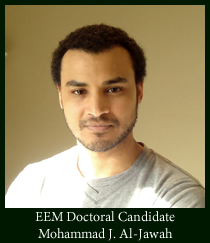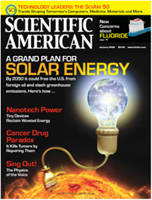Two Environmental and Energy Management doctoral students successfully defended their dissertation proposals in cutting-edge areas of renewable energy during the Fall 2012 semester.
Steven Burns

On September 26, 2012, Steven S. Burns defended his proposal to develop a macroscale model to assist key government officials in planning and designing a large-scale build-out of a direct current transmission system in the United States. Steve’s proposal, entitled “Optimal Large Scale Renewable Energy Integration: Implementing the Solar Grand Plan,” addresses the need for a major direct current (DC) transmission system for the concept known as the “Grand Solar Plan” popularized by a feature article, authored by Ken Zweibel, Director of GW’s Solar Institute, in a recent issue of the Scientific American magazine.
Given renewable energy's limited carbon footprint combined with the fact that it can be installed in a dual land use capacity (i.e., wind turbines in farm land) or in marginal lands (i.e., solar fields in unoccupied desert spaces), many factors point to renewable energy as a pathway to meeting energy needs while limiting concerns of fuel price volatility and climate change. However, the long transmission distances involved and associated transmission losses that would occur over the existing transmission network indicate a need for an extensive transmission infrastructure upgrade and buildout to support cost effective large-scale renewable energy integration. This buildout will have to consider regional load balancing to support power grid stability; the optimal transfer of power between regions; and the relative need of the regions to obtain renewable energy from remote sources.
Steve’s work is relevant to projections by some exerts that the major transition that currently is underway from fossil fuels to renewable energy likely will require a significant electric transmission infrastructure buildout - a buildout that some liken to that required of the Eisenhower Interstate System. With varying mandates among states, and the lack of a true cost advantage for renewable energy in most locations, the necessary infrastructure buildout is under risk of occurring within limited, disparate contexts. The optimal buildout scenario would determine time and place infrastructure upgrades as needed, accounting for energy demand across the nation as opposed to within individual regions. This optimized buildout would limit waste and therefore lessen consumer costs and improve system reliability.
Steve’s proposal details an effort to move from a theoretical construct to an implementation plan for large-scale renewable energy development under varying key regulatory, demand, and technical inputs. It is expected that federal and state regulators and the development community will be able to use the results of this effort to more cost effectively plan for large-scale renewable energy deployment.
Serving on Steve’s Research Advisory Committee are Professors Hernan Abeledo, Michael Duffey, Joost Santos, and Jonathan Deason.
Mohammad Al-Jawah

On December 4, 2012, Mohammad J. Al-Jawah defended his proposal to develop a decision aiding framework for investing in cleaning systems for solar photovoltaic (PV) power plants in arid regions. Mohammad’s research is motivated by recognition that the oil and other carbon based energy sources of Middle Eastern countries such as Kuwait, Qatar, the UAE and Saudi Arabia are finite, pointing to the need for such countries to plan now for a major transition in the near- to intermediate-term future. That recognition recently has led to a strong interest in developing renewable energy sources on a large scale in a number of Arabian Gulf states, including g the UAE, Saudi Arabia, and Oman, all of which are starting to invest heavily in solar energy projects and the development of renewable energy technology.
This quest for shifting to sustainable energy from the sun is reinforced by the fact that the Middle East is one of the wealthiest regions on earth in terms of solar radiation energy that can be harvested using existing technologies such as solar photovoltaic (PV) and concentrated solar power (CSP). Since the majority of lands in the Arabian Peninsula are uninhabited sandy deserts with vast solar potential, a huge potential exists for large scale solar PV installations to be built in the region. As an example, some have projected that Saudi Arabia’s annual solar energy generation by the year 2040 could be 310 TWh or 70% of that nation’s electrical energy requirements.
However, on the negative side, the Arabian Peninsula also is one of the most dust-prone regions in the world with frequent sand storms that can severely compromise the performance of PV plants. Therefore, there is a strong need to address the challenge of cleaning solar panels to ensure optimal performance and maximum energy yield. A major part of that challenge involves how to choosing the ideal method to optimize the energy yields the PV power plants in arid regions in light of numerous and complex economic, environmental, resource and social considerations.
The principal objective of Mohammad’s research is to develop a decision framework to help decision makers to optimize PV power plant performance in dust prone regions in light of multiple conflicting and non-commensurable requirements, with a focus on PV panel cleaning alternatives. To do that, Mohammad intends to assess the impacts of soiling on the performance of PV power plants, survey and gather cost and performance data about available PV cleaning alternatives, assess environmental and economic impacts of the PV cleaning alternatives, develop a decision aiding methodology to facilitate identification, sizing and configurations of optimal cleaning system, and validate study results by subject matter experts.
Serving on Mohammad’s Research Advisory Committee are Professors Julie Ryan, Michael Duffey, Royce Francis and Jonathan Deason.


